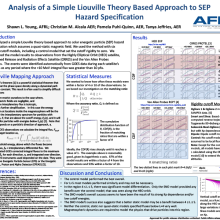Testing the Liouville theorem based SEP flux mapping method with multiple cutoff models at high altitudes and off the magnetic equator
Shawn
Young
Air Force Research Laboratory
Poster
The accurate determination of the local level of radiation exposure to satellites during a solar energetic particle (SEP) event is essential for satellite and instrument protection and for anomaly resolution. Local flux levels can be estimated through the use of rigidity cutoff models and the application of the Liouville theorem. However, the Earth's magnetic
field complicates this
computation because its location-dependent radiation shielding varies depending on the field's con guration and activity level.
Geomagnetic cutoff models have been developed to address this issue using both empirical and numerical methods. However, these approaches have limitations, the former method is usually restricted to LEO orbits because data are limited elsewhere, while the latter method can require signi cant computational resources. Fortunately, approaches to reduce these constraints exist, allowing the creation of models that are operationally feasible and valid for all of geospace.
Here we test both empirically and numerically based models against HEO satellite data. However, while cutoffs are important to determining the hazard, they are not operationally useful in and of themselves. It is the local fluxes that are the important quantity, thus we will not test the cutoff models directly. Instead we will use them as part of a method, based on Liouville's theorem, to map interplanetary
fluxes inside of geospace. We will then compare the specifi ed fluxes to those
observed on the HEO satellite. Similar work has been done using CRRES observations, but the HEO satellite will provide a test of these models off of the geomagnetic equator.
computation because its location-dependent radiation shielding varies depending on the field's con guration and activity level.
Geomagnetic cutoff models have been developed to address this issue using both empirical and numerical methods. However, these approaches have limitations, the former method is usually restricted to LEO orbits because data are limited elsewhere, while the latter method can require signi cant computational resources. Fortunately, approaches to reduce these constraints exist, allowing the creation of models that are operationally feasible and valid for all of geospace.
Here we test both empirically and numerically based models against HEO satellite data. However, while cutoffs are important to determining the hazard, they are not operationally useful in and of themselves. It is the local fluxes that are the important quantity, thus we will not test the cutoff models directly. Instead we will use them as part of a method, based on Liouville's theorem, to map interplanetary
fluxes inside of geospace. We will then compare the specifi ed fluxes to those
observed on the HEO satellite. Similar work has been done using CRRES observations, but the HEO satellite will provide a test of these models off of the geomagnetic equator.

Poster PDF
Poster category
Geospace/Magnetosphere Research and Applications
Meeting homepage